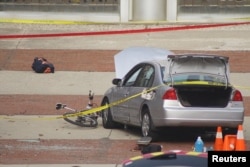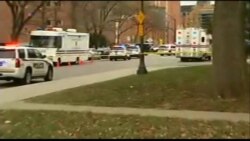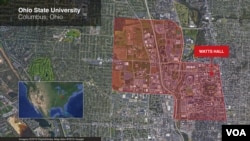A Somali student at Ohio State University drove his vehicle into a crowd of pedestrians Monday and then got out and began stabbing people, injuring 11. He was shot and killed by police.
"We have to consider that it is" a terrorist attack, said Columbus Police Chief Kim Jacobs.
Ohio State University identified the attacker as Abdul Razak Ali Artan, a student at the school. Community members in the Midwestern city of Columbus tell VOA's Somali service the man was of Somali descent and was about 20 years old.
A student of the same name was profiled in the August issue of the student newspaper, expressing concerns about the lack of Muslim prayer rooms on campus.
Hospital officials said none of the victims has life-threatening injuries.
OSU President Michael Drake said initially there were rumors of a second suspect. However, Drake said police have searched the area and believe there was only one attacker. The FBI also has joined the investigation.
Drake said he would not speculate about a motive for the attack. He said it was a deliberate attack because the suspect drove his vehicle over a curb to hit pedestrians on a sidewalk. He said the suspect then got out of the car and began stabbing people with a butcher knife.
OSU Police Chief Craig Stone said a campus officer arrived at the scene and shot and killed the suspect less than a minute after the attack began. Officials say the policeman, Alan Horujko, happened to be in the area of the attack because of a previous call and saw the scene unfold.
Students said they barricaded themselves inside classrooms and offices, pilling chairs in front of doors, when the incident was happening.
"We are scared, everybody is scared," Suad Osman, a member of Ohio State's Somali student association, told VOA's Somali service from the school's library as the incident was unfolding.
A professor at the school told VOA that his colleagues were "shaken."
WATCH: Police activity at the scene
The attack initially was reported by the university on Twitter as involving an "active shooter."
There are nearly 60,000 students at Ohio State's main campus in Columbus.
During Monday's news conference, Jacobs referenced a previous terrorism case tied to Columbus — that of Abdirahman Sheik Mohamud, who was arrested in 2015 after returning from Syria. Mohamud, a naturalized U.S. citizen originally from Somalia, was charged with providing material support to terrorists.
In September, a Somali-American man stabbed 10 people at a mall in the northern state of Minnesota, before he was shot and killed by an off-duty police officer. Officials said the suspect asked some of his victims if they were Muslim.
Columbus, Ohio, and Minneapolis, Minnesota, host the largest Somali communities in the United States.
VOA National Security Correspondent Jeff Seldin and reporters Carolyn Presutti and Harun Maruf contributed to this story.










